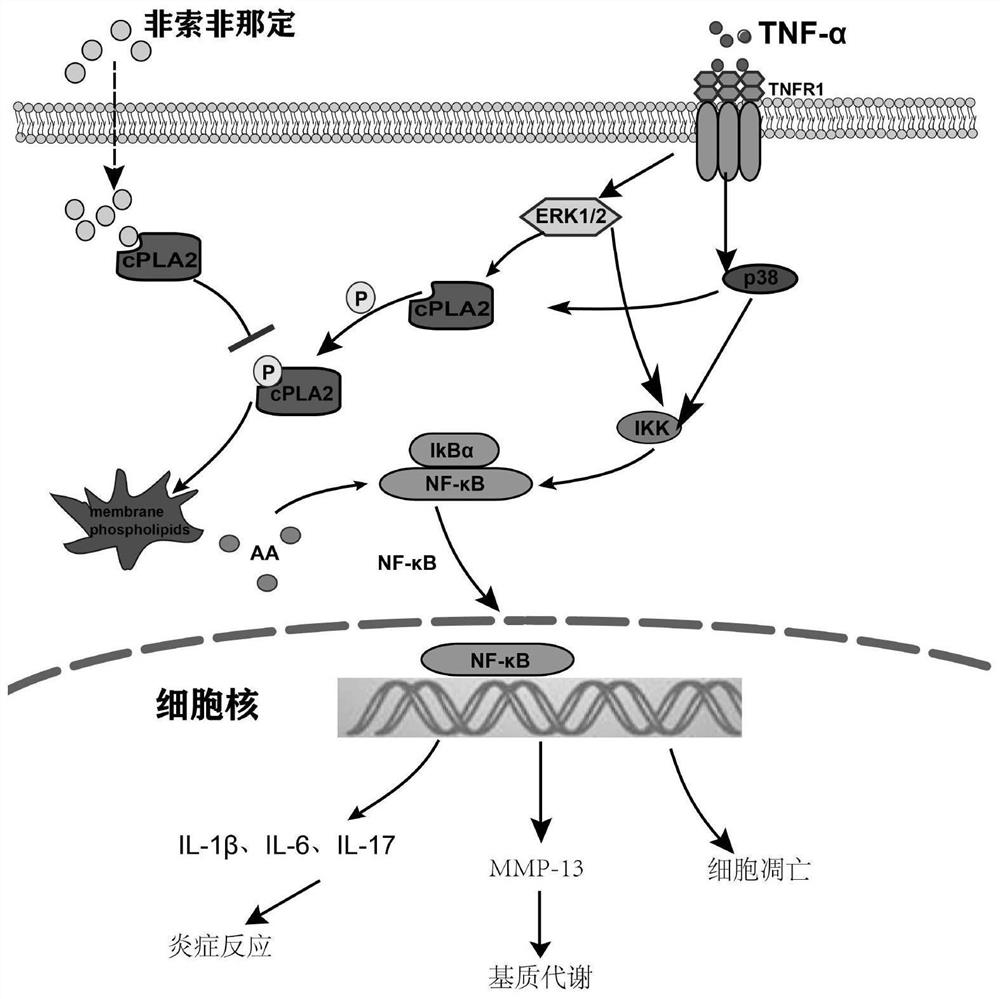Application of fexofenadine in preparation of medicine for preventing and treating intervertebral disc degeneration
A technology of fexofenadine and intervertebral disc, applied in the field of medicine, can solve the problem that the effect has not been studied yet.
- Summary
- Abstract
- Description
- Claims
- Application Information
AI Technical Summary
Problems solved by technology
Method used
Image
Examples
Embodiment 1
[0062] This embodiment verifies the efficacy of fexofenadine in preventing TNF-α-induced intervertebral disc degeneration, and the experimental method is as follows:
[0063] (1) In the case of adding or not adding fexofenadine (50uM), the mouse intervertebral disc tissue was cultured and treated with TNF-α (10ng / ml) for 7 days, and stained with Safranin O. The specific operation method is to operate according to the product manual.
[0064] Such as figure 2 As shown in , the Control group is a blank group (safranin O staining is only performed on the mouse intervertebral disc tissue, without adding TNF-α and FFD), and the TNF-α group is used without adding fexofenadine (50uM). TNF-α (10ng / ml) was cultured and treated for 7 days; TNF-α+FFD group was cultured and treated with TNF-α (10ng / ml) for 7 days with fexofenadine (50uM). Depend on figure 2 The stained pathological pictures showed that fexofenadine had a protective effect on TNF-α-induced intervertebral disc degenera...
Embodiment 2
[0074] This embodiment verifies that fexofenadine can inhibit the intervertebral disc degeneration in the tail injury rat model, and the experimental method is as follows:
[0075]A rat model of acupuncture injury was established. The method for establishing the model is as follows: after killing the mice, disinfect the skin surface with 75% alcohol. The area between the 8th and 9th tail vertebrae (Co8-Co9) of rats was punctured with a 20-gauge needle parallel to the tailbone to a depth of 5 mm. Then rotate the needle 360 degrees, in order to eliminate the injection effect, intraperitoneally inject the same volume of PBS or FFD (10mg / kg body weight) every other day
[0076] (2) After culturing and treating the tail injury rat model with or without fexofenadine (concentration 50uM) for 8 weeks, Safranin O staining and HE staining were performed on the rat intervertebral disc. The staining result is as Figure 13 (Safranin O staining) and Figure 14 Shown (HE staining).
...
Embodiment 3
[0082] This example verifies that fexofenadine can inhibit the degradation of extracellular matrix mediated by TNF-α, and the experimental method is as follows:
[0083] (1) Mice nucleus pulposus cells were treated with or without fexofenadine (10 μM) in the presence or absence of TNF-α (10 ng / mL). After 8 hours, the total RNA was extracted, and the mRNA expressions of Aggrecan, Col-II and SOX-9 were detected by PCR technique. The result is as Figure 20 shown. The figure shows that the expressions of Aggrecan, Col-II and SOX-9 in the extracellular matrix were increased in the nucleus pulposus cells of mice treated with FFD (10 μM), indicating that fexofenadine inhibited TNF-α-mediated extracellular Matrix degradation.
[0084] (2) Human nucleus pulposus cells were treated with or without fexofenadine (10 μM) in the presence or absence of TNF-α (10 ng / mL). After 8 hours, the total RNA was extracted, and the mRNA expressions of Aggrecan, Col-II and SOX-9 were detected by PC...
PUM
 Login to View More
Login to View More Abstract
Description
Claims
Application Information
 Login to View More
Login to View More - R&D
- Intellectual Property
- Life Sciences
- Materials
- Tech Scout
- Unparalleled Data Quality
- Higher Quality Content
- 60% Fewer Hallucinations
Browse by: Latest US Patents, China's latest patents, Technical Efficacy Thesaurus, Application Domain, Technology Topic, Popular Technical Reports.
© 2025 PatSnap. All rights reserved.Legal|Privacy policy|Modern Slavery Act Transparency Statement|Sitemap|About US| Contact US: help@patsnap.com



